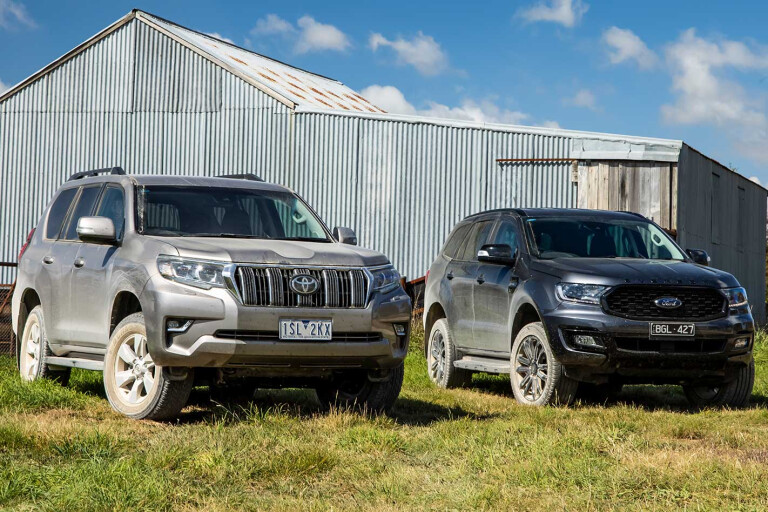
LIKE its big brother, the LandCruiser 200 Series, the 150 Series LandCruiser Prado is getting long in tooth. Released in 2009 it was in fact more of a revision of the earlier (2002) 120 Series Prado rather than an entirely new-generation model, which makes it even older than it may first appear.
Of course, Toyota hasn’t stood still in all that time, with the 150 gaining many new features along the way, most significantly a new 2.8-litre diesel engine and six-speed automatic in 2016 and now a boost in power and torque for that 2.8, and even more equipment and features across the range.
In contrast, the Ford Everest is much newer and first appeared in late 2015 (for the MY16 model year) off the back of the mid-life upgrade of the T6 Ranger.

Initially available with just the 3.2-litre five-cylinder diesel and six-speed automatic from the Ranger, for 2019 it gained an all-new 2.0-litre four-cylinder bi-turbo diesel and ten-speed automatic, which was introduced via the Ranger Raptor and also offered across the wider Ranger line-up. What we have here is the 2.0-litre powertrain in the latest variant in the Everest range, the Sport.
The Prado GXL and Everest Sport we have here are both mid-$60K plus on-road costs and, while they have similarities in basic design and intended use, they are also very different. The question is, which one is best?
TOYOTA PRADO GXL
THERE are now nine models in the expanded Prado range, but only one powertrain. No longer can you get a manual gearbox or a petrol engine. The Prado comes in just one flavour, diesel automatic.
The expansion in the number of models comes from the GXL, VX and Kakadu models all now being available with the spare wheel mounted under the body, the advantage being a much lighter and easier to operate tailgate, and separately opening tailgate glass for more convenient loading of lighter and smaller items.
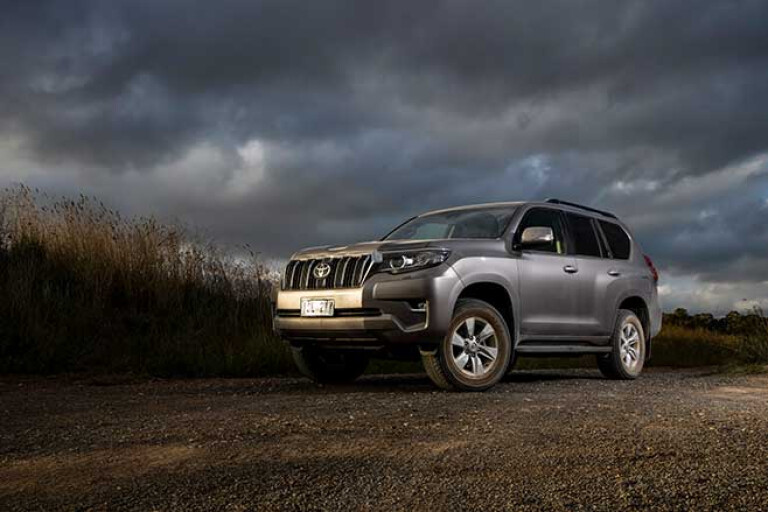
The disadvantage of having the spare wheel under your Prado is you lose the second fuel tank, which reduces the fuel capacity from 150 to 87 litres. So now there’s effectively a range of ‘suburban’ oriented Prados to complement the traditional ‘country and touring’ Prado. The relocation of the spare comes at no extra cost.
POWERTRAIN AND PERFORMANCE
IT’S not surprising that Toyota has breathed a bit more fire into the Prado’s 2.8 given it didn’t offer much more performance than the 3.0-litre diesel it replaced in 2016, just notably more refinement and cleaner emissions, which it had to do.
The performance wasn’t helped either with the then-new six-speed auto, which has two overdrive gears where the five-speed auto it replaced just had one overdrive. In fact, fifth gear in the six-speed is taller than fifth gear in the old five-speeder and then you still have the extra-tall sixth on top of that.
The extra output from the 2.8 comes essentially from a bigger turbo and higher injection pressures, but Toyota has also strengthened the cylinder block and revised the head, pistons and cooling system. On paper the power jumps from 130 to 150kW (both maximum figures at 3400rpm) while the maximum torque is now 500Nm, up from 450Nm. Importantly the maximum torque is still on tap from a low 1600rpm.

On the road this translates to noticeably less shuffling between fifth and sixth gears in give-and-take undulating country road legal-speed touring, which was a problem (and the biggest disappointment) with the lesser-output 2.8 and the six-speed auto. Obviously the two overdrive gears are all about economy but as with many such things, functionality is often sacrificed at the altar of fuel economy.
Pedal to the metal the revised 2.8 also goes noticeably harder than before, but it’s still no rocket given the economy orientated gearing and the vehicle’s overall weight and size holding it back. Certainly driven back-to-back with the Everest, the Prado feels comparatively lethargic due largely to the fact that the Everest has more gears to play with.
As ever the 2.8 is relatively quiet, smooth and refined, although with all of those attributes it still falls short of the Everest. Likewise the Prado’s refined and seemingly more proactive than before automatic is not as slick changing as the Everest’s 10-speed, at least most of the time.
There’s no mention of electronic tweaks to the Prado’s auto in Toyota’s press material but it stands to reason that the gearbox’s shift protocols would be retuned for the engine’s higher output.
ON-ROAD RIDE AND HANDLING
AS ever the Prado has a pleasantly comfortable and quiet ride largely thanks to its softly sprung long-travel suspension, but also helped by the 17-inch wheel and ‘tall’ tyre package that the GXL wears. Higher spec models wear 18s with marginally lower profile tyres.
The downside of this is that Prado doesn’t like tight winding roads and if pushed, suffers noticeably from body roll and understeer. In the company of the Everest Sport, which admittedly rides on low-profile 20s, the Prado feels soggy. Toyota has the answer to this with its brilliant KDSS system, but that’s never been available on GXL and was even dropped from the VX from 2018 on. The only Prado with KDSS now is the Kakadu, which also gets driver-selectable damping and auto-levelling and height-adjustable rear suspension, a complication not everyone may want.
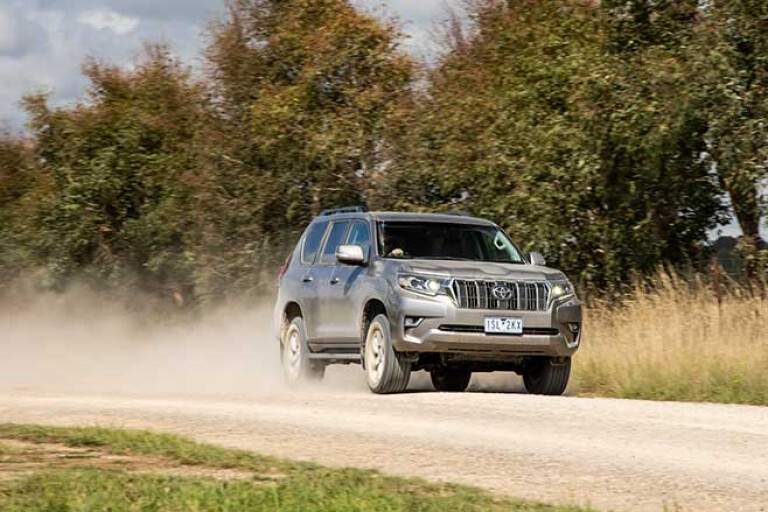
Still for all that the Prado’s steering response and general handling is more than acceptable, and its highpoint is the ease in which it eats up the miles even on bumpy and poor-quality roads. Full-time 4x4 helps too for more demanding touring conditions on wet or otherwise slippery roads.
Locating the spare under the car also makes for a slightly lighter Prado and one with a more handling-friendly weight distribution, but you would need to drive both variants side by side to learn the extent of the benefit. It counts for little against the Everest.
OFF ROAD
WHAT works for the Prado’s on-road ride, namely its compliant long-travel suspension, is also the secret behind its impressive off-road ability, even on the standard tyres. Change the tyres to something more robust and ditch the sidesteps and the Prado would be even more impressive, even if you change nothing else.
The Prado’s mechanical full-time 4x4 system has a Torsen limited-slip centre diff, which means that there’s no need to lock the centre diff for easier off-road excursions. Ramp up the difficulty and there’s a push-button lock for the centre diff, and there’s also a similar arrangement for the rear diff, although activating the rear locker cancels the electronic traction control (ETC) on both axles.
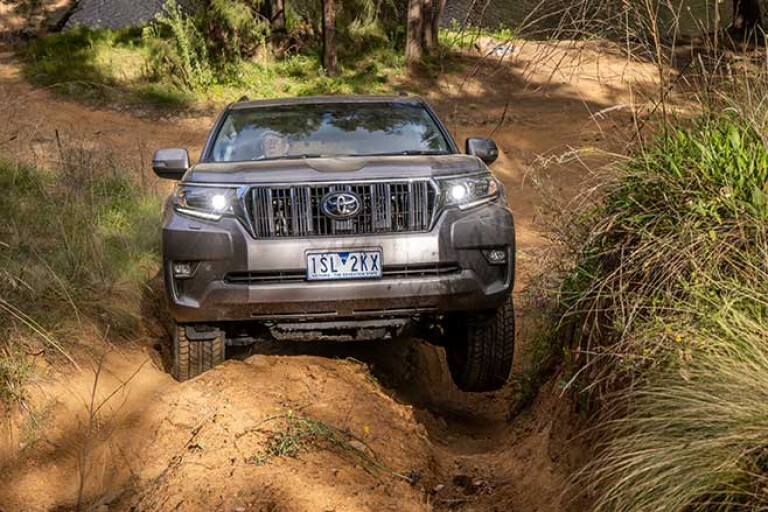
Given the Prado’s ETC works so well off road with specific calibration for when low range is selected, the rear locker is almost redundant.
The Prado betters the Everest for wheel travel but the Everest counters with a rear locker that doesn’t cancels the ETC on the front axle, which evens things up, although in this contest the Everest is severely hampered off road by its 20-inch wheel and tyre package. Points also for the Prado’s more solid-looking recovery hooks compared to the Everest, and with its engine air-intake location.
CABIN, ACCOMMODATION & SAFETY
CLIMB into the Prado and you’re greeted with a familiar and somewhat dated looking dash even if the touchscreen is a tad bigger. Still everything is easy to use with big, easy to read switchgear.
Our test GXL was fitted with the ‘premium’ interior, which means leather, heated and cooled seats up front, rear heated seats and electric adjust for the driver’s seat. Up front the driver gets the benefit of both tilt-and-reach steering wheel adjustment, so one up on the Everest, which is tilt only.

As ever the Prado is spacious and comfortable up front, while the rear seat is better suited to two adults and child, rather than three adults. The third row is easy to get in and out of and can take adults at a squeeze for a short distance, but the seats themselves are difficult to deploy from their underfloor position. And once the third row is deployed there’s little room left for luggage.
Automatic emergency braking is the headline safety act, while there’s also lane-keeping assistance via selective brake application – no electric steering for this, which is the norm with lane-keeping assistance. The GXL doesn’t however have blind-spot monitoring or rear cross-traffic at this spec level. For both you need to move up to the VX.
PRACTICALITIES
SINCE the 2018 model year, automatic Prado’s have been upgraded to a 3000kg towing limit, a notable improvement over the previous 2500kg limit, thanks to a Gross Combination Mass upgrade from 5370kg to 5990kg. The Everest is still rated to tow a little more at 3100kg, but the difference is largely academic.
Flat tailgate Prados are also 60kg lighter than comparable models with the spare on the tailgate, which gives the equivalent bonus in payload and betters the Everest.
WHAT YOU GET
THE Prado comes in GX, GXL, VX and Kakadu equipment levels and all but the GX come with the option of having the spare wheel either on the tailgate or under the car. All models get high-end safety features headlined by automatic emergency braking. All models also get a new-generation multi-media system with a 9-inch touchscreen, enhanced voice recognition and compatibility with Apple CarPlay and Android Auto, and automatic wipers.
Key equipment on the base GX includes sat-nav, keyless entry and start and 17-inch wheels. Third-row seats are optional on the GX but standard on the GXL, which also gains side-steps, roof rails, three-zone climate control, and LED headlights, fog lights and daytime running lights.
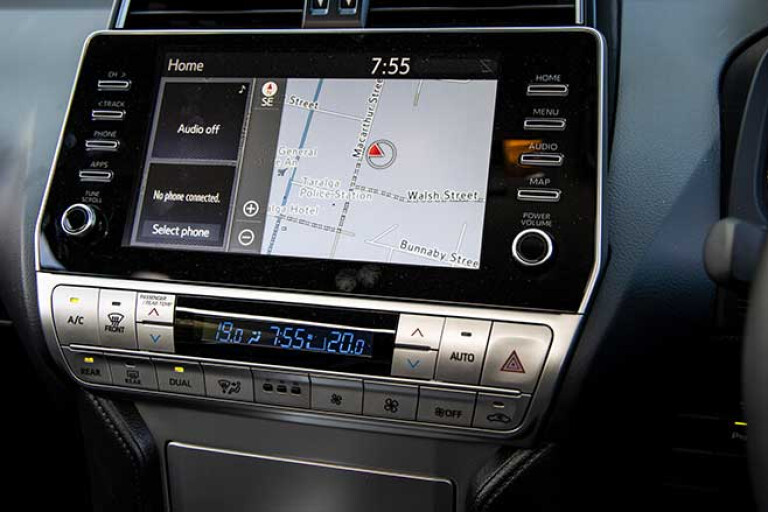
Optional on the GXL but standard on the VX is leather, heated front and outside mid-row seats and electric adjust on the front seats. The VX also gains 18s, premium sound (with digital radio), terrain monitoring cameras, blind-spot monitoring and rear cross-traffic alert.
From there the Kakadu adds a sunroof, KDSS, adaptive and adjustable suspension with rear auto-levelling, Crawl Control, terrain-specific electronic chassis controls and rear-seat entertainment.
TOYOTA PRADO PRICES
GX: $59,840
GXL: $66,540
VX: $76,380
Kakadu: $87,030
Prices do not include government or dealer charges.
SPECS: TOYOTA PRADO GXL (FLAT TAILGATE)
ENGINE: 2.8-litre 4-cyl turbo diesel
MAX POWER: 150kW at 3400rpm
MAX TORQUE: 500Nm at 1600 to 2800rpm
GEARBOX: Six-speed automatic
4X4 SYSTEM: Dual-range full-time
CRAWL RATIO: 36.1:1
CONSTRUCTION: Separate-chassis
FRONT SUSPENSION: Independent/coil springs
REAR SUSPENSION: Live axle/coil springs
TYRES: 265/65R17 112S
KERB WEIGHT: 2225kg
GVM: 2990kg
PAYLOAD: 765kg
TOWING CAPACITY: 3000kg
GCM: 5990kg
FUEL TANK CAPACITY: 87L
ADR FUEL CLAIM: 8.0L/100km
TEST FUEL USE: 13.5L/100km
GROUND CLEARANCE: 220mm
APPROACH ANGLE: 32º
RAMPOVER ANGLE: 22º
DEPARTURE ANGLE: 25º
WADING DEPTH: 700mm
FORD EVEREST SPORT
THE Sport joined the Everest line-up for the 2020 model year and is effectively a ‘blacked out’ styling exercise based on the Trend.
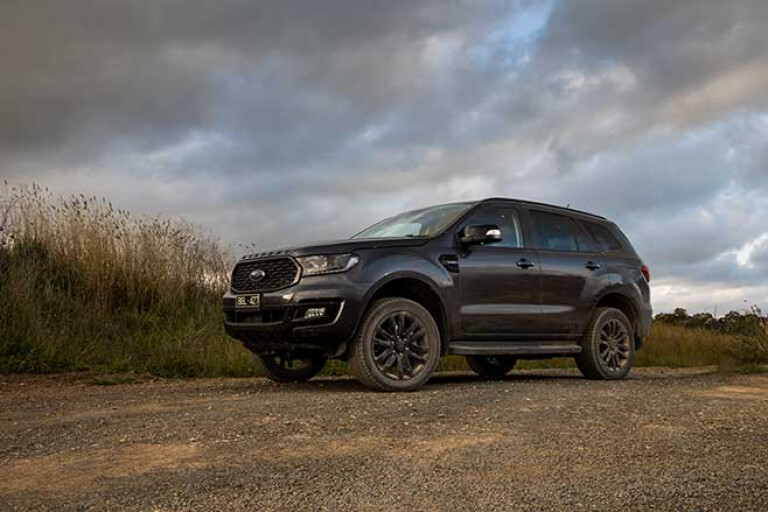
Mechanically, the only change is the adoption of 20-inch wheels in place of the Trend’s 18s. The Sport also has the new Bi-LED headlights and automatic high-beam lighting system, also introduced on the Trend and top-spec Titanium models for 2020.
The Sport is 4x4 only (no budget rear-drive-only model) and only come with seven seats. There is however the choice of two powertrains, the familiar 3.2-litre five cylinder diesel and accompanying six-speed automatic or the 2.0-litre bi-turbo diesel with its 10-speed automatic, which we have here.
POWERTRAIN & PERFORMANCE
THE Sport’s 2.0-litre bi-turbo diesel and accompanying 10-speed auto is at the pointy end of diesel design and incorporates the sort of technology that could well see out the diesel’s final days as emission regulations become tighter, and bans on diesel and petrol engines potentially kick in at the end of the decade. At this stage the thinking is that this engine will power the new generation Ranger (due 2022) and the next Everest, assuming of course there is one.
Fire up Everest’s four-cylinder bi-turbo diesel and the first surprise is how quiet and smooth it is, on both counts better than the Prado, which is still a refined diesel in its own right.

Once underway this is no small engine struggling to push a big and heavy 4x4. In fact it’s a small engine that feels like a big engine and certainly more punchy than the considerably bigger 2.8 in the marginally lighter Prado, although having 10 close-spaced gears in what is a sporty gearbox compared to the Prado’s more economy-focused six-speed certainly plays a major part here.
The Everest’s trick is of course, it’s bi-turbo system where a fast-spooling little turbo gets the engine up and running off idle before handing over to the big turbo to do the heavy lifting at middle and high rpm. Despite its relatively diminutive capacity the Everest actually makes more peak power than the Prado (157kW vs 150kW) and matches the Prado’s 2.8 in terms of peak torque (500Nm) at close to the same low rpm.
Meanwhile, the Everest’s 10-speed automatic offers slick and well-timed shifts 99 per cent of the time although it can be caught out at times, hesitate for a second, then shift with a jolt. ‘Manual’ gear selection, if you want it, is via a switch on the side of the shift lever.
ON-ROAD RIDE & HANDLING
THE Everest is a little heavier than the Prado, but feels much lighter and more nimble. Less understeer when pushed hard too. The feel and the feedback from the Everest’s electric power steering is also better than the Prado’s hydraulically assisted steering and offers much reduced effort at parking speeds (and off-road speeds).

Generally tidier handling too on faster bumpier roads due in part to the Everest having a sophisticated ‘engineer’s solution’ Watt’s Link rather than a cruder ‘production-cost solution’ Panhard rod to laterally locate its rear axle, which eliminates the rear bump-steer that can trouble the Prado on bumpier roads.
On the downside the Sport’s ride is firmer than the Prado and the road noise more noticeable, much of which you can put down to the Sport’s 20-inch wheel-and-tyre package.
OFF ROAD
THE Everest’s on-road finesse doesn’t come at the expense of its off-road ability. Far from it, in fact. The Everest may not have as much wheel travel as the Prado but the electronic traction control stays active on the front axle when the driver-activated rear locker is engaged, which is not the case with the Prado.
Unlike the Prado, which has a mechanical centre diff, the Everest has an electronically controlled clutch-style centre diff that can vary the amount of torque sent to either axle. It’s effectively a full-time system in as much as the driver doesn’t have to select 4WD. On a high-traction surface the Everest splits the drive 40/60 front to rear, but can reduce or increase the drive to the front as needed.
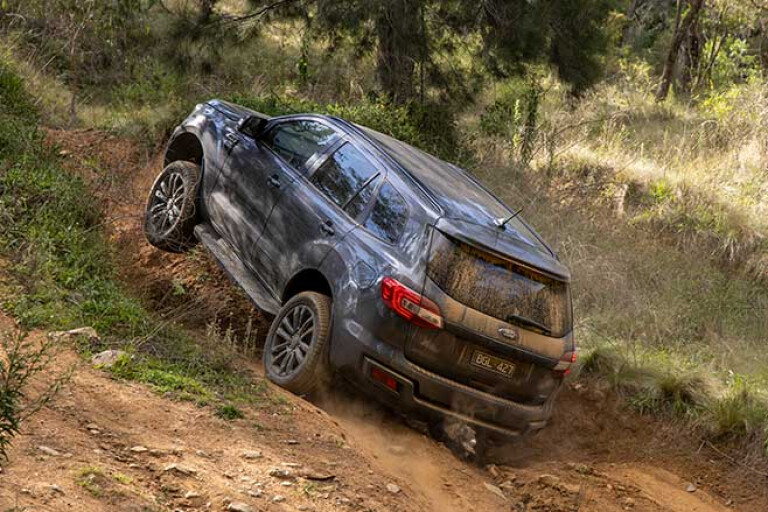
The electronically controlled centre ‘diff’ also plays a part in the Everest’s terrain-specific drive models, namely ‘Snow/Mud/Grass’, ‘Sand’ and ‘Rock’, as well as a ‘Normal’ mode. The only problem here is that when low range is selected you can’t also select ‘Sand’.
The Sport’s 20-inch wheel and tyre package also do it no favours off road, but at least the tyres don’t have a notably high speed rating, which would make them even more unsuitable for off-road use. Either way, it is easy enough to swap to a more practical wheel/tyre combination. In fact Ford offers an off-road wheel-and-tyre package for the top-spec Titanium, which also comes with 20s as standard. Bespoke black 18s with all-terrains from the factory would be a nice option on the Sport.
The Everest claims 100mm more wading depth than the Prado despite the engine air-intake being more exposed and its recovery hooks don’t look as heavy-duty as those on the Prado.
CABIN, ACCOMMODATION & SAFETY
LIKE the Prado, the Everest has smart-key entry and push-button start and once inside, you’ll find a cabin that’s nicely detailed and finished with detailing to the (leather) seats and door trims that’s unique to the Sport. As ever, some of the Everest’s switchgear is too small and not user friendly, the HVAC controls being the notable offender.
There’s no steering wheel reach adjustment for the driver but it’s not hard to find a comfortable driving position given the front seats are more comfortable than the Prado’s.
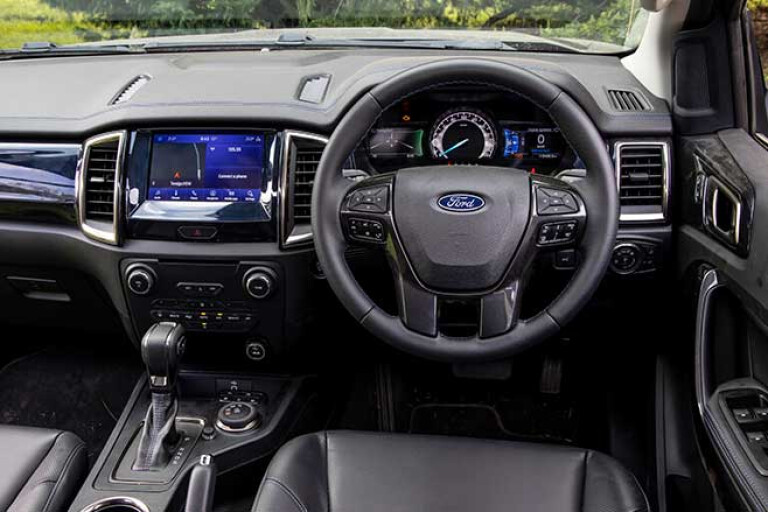
The second row seat offers more shoulder room than the Prado and a better centre pew but the legroom isn’t as good, even if there’s room for a six-foot passenger to sit behind a six-foot driver. Like the Prado, the Everest’s middle-seat can be adjusted fore and aft, which allows you to balance the legroom between the second and third rows.
The third-row seats have electric deployment, an improvement on Prado but aren’t as easy to access. The comfort and room in the third row is comparable to Prado, but there’s more luggage room behind the third-row seat in the Everest when the third row is deployed.
Like the Prado, the Everest gets automatic emergency braking and a similar range of other safety equipment, but like the Prado GLX the Everest Sport doesn’t have blind-spot monitoring.
PRACTICALITIES
THE Everest claims more towing capacity than the Prado but for heavy-duty towing, an Everest with the 3.2-litre five-cylinder engine will tow better than both the 4x4s here, despite the fact that the 2.0-litre claims more power and torque than the 3.2L. What works on paper doesn’t’ necessarily work on the road, as previous testing has shown.
The Everest is a little short of the as-tested Prado’s payload but that difference evaporates if you opt for the slightly heavier spare-on-the-tailgate GXL variant.
The Everest’s 80-litre fuel capacity is well short of the 150 litres you get with a rear-mounted-spare Prado and still 7 litres short if you opt for the spare under your Prado.
WHAT YOU GET
INTRODUCED for the 2020 model year, the Sport sits between the mid-spec Trend and top-spec Titanium in the Everest line-up. Standard equipment on the Sport extends to smart-key entry and start, leather, power-adjust driver’s seat, dual-zone climate control, an 8-inch touchscreen, sat-nav, 10-speaker audio with digital radio, rain-sensing wipers, Bi-LED auto headlights with automatic high beam, third-row seats, LED DRLs, and a rear locker.

The Sport is distinguished by black lower bumper sections front and rear, black exterior mirrors, black window surrounds and black roof rails. The Sport also rides on bespoke black 20s. Safety kit includes autonomous braking, radar cruise, lane-keeping assist, traffic-sign recognition, and front, side, full-length curtain and driver’s knee airbags
FORD EVEREST 4X4 PRICES
3.2 Ambiente: $55,090
3.2 Trend: $60,890
2.0 Trend: $62,390
3.2 Base Camp: $63,090
2.0 Base Camp: $64,590
3.2 Sport: $62,890
2.0 Sport: $64,390
2.0 Titanium: $73,190
*Prices do not include government or dealer charges.
SPECS: FORD EVEREST SPORT 2.0L
ENGINE: 2.0-litre 4-cyl bi-turbo diesel
MAX POWER: 157W at 3750rpm
MAX TORQUE: 500Nm at 1750 to 2000rpm
TRANSMISSION: Ten-speed automatic
4X4 SYSTEM: Dual-range on-demand
CRAWL RATIO: 42.2:1
CONSTRUCTION: Separate-chassis
FRONT SUSPENSION: Independent/coil springs
REAR SUSPENSION: Live axle/coil springs
TYRES: 265/50R20 107T
KERB WEIGHT: 2406kg
GVM: 3100kg
PAYLOAD: 694kg
TOWING CAPACITY: 3100kg
GCM: 5900kg
FUEL TANK CAPACITY: 80L
ADR FUEL CLAIM: 7.0L/100km
TEST FUEL USE: 13.5L/100km
GROUND CLEARANCE: 227mm
APPROACH ANGLE: 29.5º
RAMPOVER ANGLE: 21.5º
DEPARTURE ANGLE: 25º
WADING DEPTH: 800mm
THE VERDICT
CHOOSING a winner here may come down to you being a ‘Toyota’ person or a ‘Ford’ person. Both brands tend to generate loyal followers and strident detractors.
In one way the choice is simple. If you’re a keen driver who places a premium on dynamics, handling and performance, there’s only one choice and that’s the Everest. And the Everest’s superior on-road performance doesn’t mean it can’t match the Prado off road. The Everest’s interior packaging is also a little better, even if the Prado looks a little bigger from the outside.
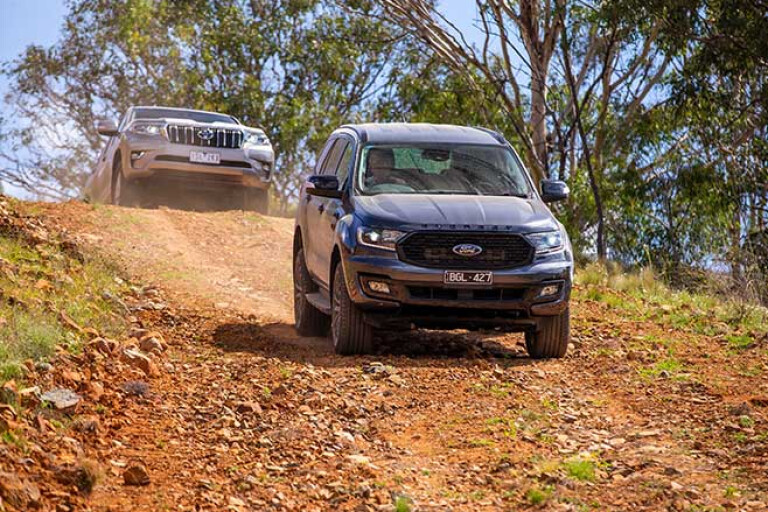
The Prado comes back into the contest in the way that all Toyota’s tend to do. It has a simpler, lower-stressed engine and a well-proven Aisin automatic gearbox widely used by Toyota and others. Even the Prado’s 4x4 system is simpler and doesn’t rely on electronics.
For those interested in remote-area travel the 150-litre fuel capacity that you get with the Prado when the spare is mounted on the rear door is also a major bonus. The extensive range of aftermarket enhancements available for the Toyota is also a bonus even if there’s a fair range of extra kit for the Everest.
So while the Everest is a better 4x4 to drive, the Prado may be a better 4x4 to own. The choice is yours.

COMMENTS